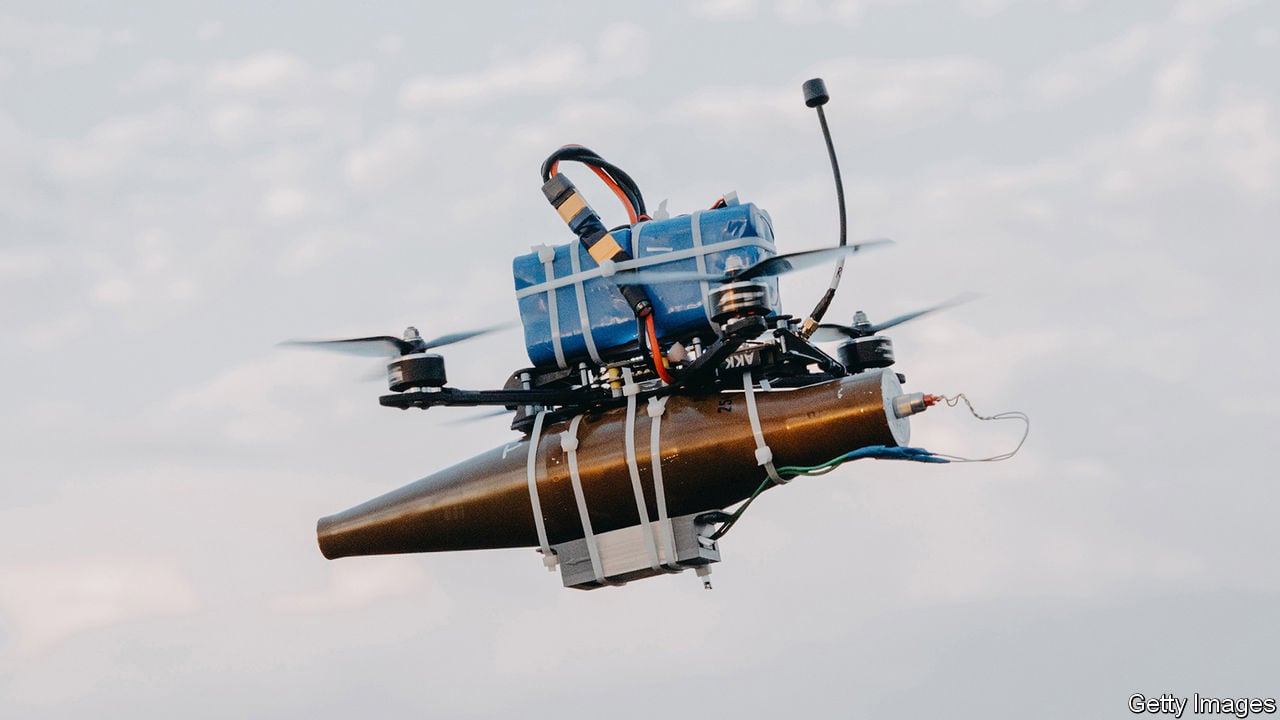The wars of the future will not be fought on the battlefield or at sea. They will be fought in space, or possibly on top of a very tall mountain. In either case, most of the actual fighting will be done by small robots. And as you go forth today remember always your duty is clear: To build and maintain those robots.
What’s that from? The Simpsons?
The Secret War of Lisa Simpson, Season 8, Episode 25. First aired in 1997.
Clip. Voiced by Willem Dafoe.
Yes. I’m a man of few words.
I think they are perfectly cromulent words.
Perhaps instead we could just restructure our epistemically confabulated reality in a way that doesn’t inevitably lead to unnecessary conflict due to diverging models that haven’t grown the necessary priors to peacefully allow comprehension and the ability exist simultaneously.
breath
We are finally coming to comprehend how our brains work, and how intelligent systems generally work at any scale, in any ecosystem. Subconsciously enacted social systems included.
We’re seeing developments that make me extremely optimistic, even if everything else is currently on fire. We just need a few more years without self focused turds blowing up the world.
We are finally coming to comprehend how our brains work, and how intelligent systems generally work at any scale, in any ecosystem.
Who told you that?
(If you don’t mean ML-based things fallaciously called “AI”, then ignore this)
I’m talking about the general strides in cognitive computing and predictive processing.
https://youtu.be/A1Ghrd7NBtk?si=iaPVuRjtnVEA2mqw
Machine learning is still impressive, we just can better frame the limitations now.
For the note on scale and ecosystems, review recent work by karl friston or Michael Levin.
Here is an alternative Piped link(s):
https://piped.video/A1Ghrd7NBtk?si=iaPVuRjtnVEA2mqw
Piped is a privacy-respecting open-source alternative frontend to YouTube.
I’m open-source; check me out at GitHub.
Thanks, watching now
robots, satellites, or for that matter fighter jets or artillery can’t hold ground, all these units work in support of infantry. the future belongs to what we already have: combined arms warfare
robots…can’t hold ground
Maybe not yet. Maybe not even soon. But it will happen.
https://www.youtube.com/watch?v=-e1_QhJ1EhQ
At some point, you’re going to have legged robots out there, and that’ll start cutting into human advantages in mobility over rugged terrain.
BigDog got rejected by the Marines because it was too loud. But that’s not really a fundamental limitation of robotics.
https://en.wikipedia.org/wiki/BigDog
At the end of December 2015, the BigDog project was discontinued. Despite hopes that it would one day work like a pack mule for US soldiers in the field, the gas-powered engine was deemed too noisy for use in combat. A similar project for an all-electric robot named Spot was much quieter, but could only carry 40 pounds (18 kg). Both projects are no longer in progress, but the Spot Mini was released in 2019.[2][11]
That’s just a load-bearer. But once you have a platform that’s mobile and can go most places a human can, it’s gonna get armed pretty quickly.
And it won’t happen all at once – you’ll have some humans, some robots. Maybe they just have load-bearers, like what DARPA was interested in BigDog doing. Maybe a robot gets put on point when a squad is patrolling.
But the cost of a human life is pretty high, so there’s a pretty potent incentive to consume a robot than a human life if possible.
Here is an alternative Piped link(s):
https://www.piped.video/watch?v=-e1_QhJ1EhQ
Piped is a privacy-respecting open-source alternative frontend to YouTube.
I’m open-source; check me out at GitHub.
It’s completely idiotic and against all existing reason to allow a machine to end lives on automatic. I don’t think it’s going to be allowed and heavily frowned upon kind of like mustard gas
robots can’t hold ground
Tell that to an auto turret that shoots anyone that approaches it.
Tell that to the cardboard box crawling its way towards the auto turret because the auto turret doesn’t scan it human
Tell that to the robotic dogs who have a heightened sense of robo-smell and can detect the guy hiding inside the cardboard box
Tell that to the perfume that places the dog instantly in debug mode and allows for remote access and subsequent flooding of the controller local net
Tell that to the special gasmasks the robodogs wear as a countermeasure against the debug mode perfume
is that autoturret in the room with us?
If it was, we’d be dead
deleted by creator
deleted by creator
States don’t concede wars because of equipment losses—they concede when the cost in lives becomes an existential threat to the ruling regimes. Drones fighting drones means nothing to governments unless there are human lives at stake when the drones break through.
What are they supposed to break through
most of the actual fighting will be done by small robots.
Drones aren’t being used to kill other drones, they are being used to drop bombs on people
Can we please just fight all of our wars on the moon with giant robots like God intended?
Not as things stand from a treaty standpoint.
https://en.wikipedia.org/wiki/Outer_Space_Treaty
The Outer Space Treaty, formally the Treaty on Principles Governing the Activities of States in the Exploration and Use of Outer Space, including the Moon and Other Celestial Bodies, is a multilateral treaty that forms the basis of international space law. Negotiated and drafted under the auspices of the United Nations, it was opened for signature in the United States, the United Kingdom, and the Soviet Union on 27 January 1967, entering into force on 10 October 1967.
https://en.wikisource.org/wiki/Outer_Space_Treaty_of_1967
Article IV
States Parties to the Treaty undertake not to place in orbit around the earth any objects carrying nuclear weapons or any other kinds of weapons of mass destruction, install such weapons on celestial bodies, or station such weapons in outer space in any other manner.
The moon and other celestial bodies shall be used by all States Parties to the Treaty exclusively for peaceful purposes. The establishment of military bases, installations and fortifications, the testing of any type of weapons and the conduct of military manœuvres on celestial bodies shall be forbidden. The use of military personnel for scientific research or for any other peaceful purposes shall not be prohibited. The use of any equipment or facility necessary for peaceful exploration of the moon and other celestial bodies shall also not be prohibited.
Well, Russia hasn’t actually violated it yet. We just have intelligence that it was being considered.
If the treaty breaks down, then, yeah, maybe we could see war on the Moon in the future.
deleted by creator
Drones currently outpace their countermeasurs. This will definitely not be a thing forever. I think the effectiveness of cheap drones will go down as be countermeasures are invented.
We already see new very effective military drone jammers starting to come out
Onboard AI guidance is not difficult.
Yes it is.
Both of you are right.
It’s difficult, but how difficult depends on the task you set. If the task is “maintain manually initiated target lock on a clearly defined object on an empty field, despite the communications link breaking for 10 seconds” -> it is “give a team of coders half a year” difficult. It’s been solved before, the solution just needs re-inventing and porting to a different platform.
If it’s “identify whether an object is military, whether it is frienly or hostile, consider if it’s worth attacking, and attack a camouflaged target in a dense forest”, then it’s currently not worth trying.
That was a good guess but unfortunately it is just difficult even in the scenario you proposed
Realtime person detection and following it with a drone? Difficult for me, certainly, but there are enough people out there who have done it.
I will be very suprised if this isn’t already happening.
It’s one thing detecting a person with machine learning in a test and an actual soldier with camouflage in a very imperfect environment. Also good luck telling friend from foe from civilian.
This has all sorts of problems while making the whole system more complicated and prone to issues. Not the mention moral questions of autonomous weapons. I have no doubt it will happen but not yet, not here.
Why would the drone differentiate an armed person from a civilian? I mean, you’ll be asking to separate out children next, at that rate!
I know it already does, at least in newer Lancets. Expect this in fpv type devices soon.
You can’t be serious.
Tracking a moving object in realtime with video is a standard task for a machine learning engineer. You can do it on an embedded platform with ML hardware support. I don’t know what hardware newer Lancets use but they can already do it according from developer reports from Telegram channels like e.g Разработчик БПЛА.
Honestly, I was just objecting to the use of “AI”. We’ve had both fire and forget and loitering munitions for decades now, neither of which use ML. Will it happen? Sure. For now, ML/AI is too unreliable to be trusted in a deployed direct attack platform, and we dont have computing hardware powerful enough to run ML models that we can jam in a missile.
(Though yeah we run tons of models against drone data feeds, none of those are done onboard…)
For now, ML/AI is too unreliable to be trusted in a deployed direct attack platform
And probably can’t ever be trusted. That “hallucinations can’t ever be ruled out” result is for language models but should probably apply to vision, too. In any case researchers made cars see things and AFAIU they didn’t even have to attack the model they simply confused the radar. Militaries are probably way better at that than anything that’s out in the open, they’ve been doing ECM for ages and of course never tell anyone how any of it works.
That doesn’t mean that ML can’t be used, though, you can have additional non-ML mission parameters such as the drone only acquiring targets over enemy territory. Or that the AI is merely the gunner, there’s still a human commander.
The point of modern deep learning approaches is that they’re extremely easy on the developer skill. Decades ago realtime machine vision needed a machine vision expert, these days you throw the hardware at the problem at learning stage, and embedded devices to run the results are stupidly powerful (doesn’t even take a Jetson board), if you compare to what has been available even a decade ago.
A combination of GPS, or even inertial based guidance to get them to the target area and then some simple vehicle / object identification, I’d think those are possible.
GPS is usually the first thing to be jammed in the battlefield.
GPS is useful, but not required for operation. Inertial guidance, and ground tracking cameras can easily maintain a good position sense, while completely RF passive. This is also already normal on many toy drones.
You would also want to jam it over a large area. That jamming is akin to a “kick me” sign, in neon lights.
Inertial guidance sucks balls for any meaningful amount of time. Combining it with ground tracking gets it a lot better, if you have good time of flight sensors to measure the distance from the ground. But this also falls flat on its face when the ground is too uniform (grassland, wetland, snow etc).
Edit, apparently I’m an idiot and my ability to tell truth from fiction is a lot worse than I thought.
In my defence however, all the parts are completely viable. I also saw it mixed in with Boston dynamics videos.
I’ll leave the original comment for context of my folly.
The US already has them.
There are single shot drones, designed to be deployed into a building, or cave system. They then use cameras etc to navigate, while running face recognition. When they find their target, they fly just in front of it. The shaped C4 charge is designed to reduce their head to red mist, while not risking those close by.
AI + cheap drones will completely change warfare. Probably on the same level as the tank, or machine gun.
The US already has them.
Do you have a source for this? These sound uncannily close to the Slaughterbots short film…
I’ll try and remember to dig it out later. It was a sales demo from a weapon’s company. I can’t remember exactly which one it was, but the implications scared the shit out of me.
Are you certain you’re not thinking of the Sci-Fi Short Film “Slaughterbots”? The plot is almost exactly what you describe.
Apparently I’m an idiot. I saw a modified version, mixed in amongst other legit videos.
Here is an alternative Piped link(s):
Sci-Fi Short Film “Slaughterbots”
Piped is a privacy-respecting open-source alternative frontend to YouTube.
I’m open-source; check me out at GitHub.
Imagine when they are long range and readily available. Any old despot could load on a rough GPS location and a face. Deniable foreign assassination becomes easy.
You can’t be very knowledgeable on the topic.
I am, in fact, fairly well versed in the topic. You’re 30+ years away from being able to fit hardware powerful enough to run a ML model into a missle, though I cant see a single reason you’d ever want to. Look into the declassified, 40+ year old design paradigms for missiles or other self-guided munitions and it’ll start to give you an idea of why the idea of “AI” guidance is so laughably stupid. There’s so very many reasons we use FPGAs, none of which are compatible with AI.
I saw a YouTube clip explaining that they use a secondary drone to boost the signal to get around some of the jamming.
The game of cat and mouse continues.
The only reliable counter to a drone is likely another drone.
I suspect Peter F Hamilton got it close, in the Confederation series, with WASPs. They are space based weapon platforms. They carry a mix of offensive and defensive subsystems, and operate with swarm logic.
I could easily see a larger drone carrying a swarm of 1 shot micro drones. When close, some would be sacrificed to get better sensor data, others would go on the attack. Conversely, a defensive target would launch their own swarm. It’s goal would be to stop the attackers getting a good shot on a high value target. It might also counterattack, either against the mother ship drone, or backtracking to find the launch site.
Jamming would also be part of this. A jammer could easily cut off the swarm from external data sources. Live satellite or remote surveillance systems would be cut. Point to point lasers are far harder, as are burst transmissions. Local sensor drones could easily punch short range data back, or paint targets, until they are destroyed by defensive systems.
There are in fact a huge number of reliable counters to drones, including but not limited to anti-aircraft gun systems, anti-aircraft lasers, RF jamming devices (especially effective against cheap/makeshift drones), and several more. Drones are currently an emergent threat without a robust countermeasure scheme, but given their massive role in the Ukraine war that is not going to go unaddressed for long. From a purely mechanical standpoint, small drone munitions are also physically very vulnerable, making them readily destroyed by anti-air autocannon fire or even laser weapons if you assume RF jamming will not solve the problem.
Between GPS (jammable but likely gets you into the target area), dead reckoning, optical flow sensors and increasingly impressive onboard camera processing, RF jamming will soon be irrelevant.
Almost a decade ago I was flying agricultural mapping missions that were 99% autonomous, and the parts that weren’t were problems a military drone doesn’t have (soft launch and landing)
The clear counter is autocannons, likely fully automated themselves to manage large swarms. The other would be cheap anti-drone missiles that either are basically a drone themselves or a glorified model rocket. Possibly tiny, cheap and fast interceptors launched from fixed-wing drones. The weak point of drones is literally their physical weakness.
It’s worth noting we are at the start of an arms race. It will iterate all over the place.
For example, smoke and chaff deploying drones would make defensive fire harder. Anti air can be either baited (and so depleted) or rushed. Lasers can be shielded against, at least for a time. Jamming can be countered with line of site communications.
In turn, each of these can be countered.
A key thing of note is that your solutions are heavy. Fine for defending a static target, but problematic when dealing with defending a mobile unit etc infantry of transports. In those situations an extremely rapid, focused highly dynamic response would be required. The obvious way to deploy those fast enough is to have them automated and airborne, aka a drone swarm.
I might be completely wrong, current drone warfare is akin to the invention of the smoothbore musket. How it will develop remains to be seen (for better or for worse).
https://www.youtube.com/watch?v=rr7ym1zkda8
Anti-air guns are the countermeasure. RADAR good enough to detect drones + an aimbot and programmable air-burst round to “shotgun” your pellets to damage those soft plastic bits.
We’re going back to WW2 tech. AA guns were considered obsolete because Helicopters + Missiles had more range. But now we need to build cheaper AA Guns for the anti-drone role.
AA Guns are also useful vs infantry, so in an infantry vs infantry fight, having an AA Gun platform will be useful even without any drones around. Airburst and rapid fire is always useful, and I expect the computers that make RADAR possible will be far cheaper today than decades past.
They may both have a role.
If you know that a given point is at risk of attack, using a static defense like AA guns is practical. Say you have some sort of specific, high-value target that you can put AA guns around. That may be a very sensible thing to do.
But the problem, if you intend to rely only on those, is that there is then a concentration of force issue. The attacker can choose which point to attack; they get the initiative.
Say you’re trying to defend against something like a Shahed-136. It can hit pretty much anywhere in Ukraine. You can’t stick an AA gun on everything that Russia might consider trading a Shahed-136 for.
But, okay, say you try to go big with static defenses. Let’s say that you can obtain and pony up the resources to hypothetically stick an AA gun at every single point along the front line and border, and that your AA gun has the altitude to hit a drone. You have an unbroken line of engagement envelope all around a country. That’d be an extraordinary expenditure, but it could hypothetically be done. So a drone has to fly through defended airspace. The problem is that if the other guy expends an equivalent amount of resources, he can buy a shit-ton of drones and fly them all through a single gun’s engagement envelope. Even if he doesn’t even bother to try to attack the antiaircraft gun, your gun defenses are just going to get overwhelmed, because all of the attacker’s resources are engaged, whereas the vast bulk of the defender’s resources are not in the fight. Maybe you hit a tiny percentage of drones, but the rest are going to be able to simply fly through.
The problem is that the cost of static defenses in that scenario grows at something like the square of the scale of the air conflict – you have to have enough static defenses to counter all of the attacker’s aircraft, and pre-place those defenses at all points that might be attacked, whereas the cost of the attack grows only linearly. It’s cost-effective to use static defenses only if the attacker is compelled to attack a limited number of points.
If that’s not the case, then using some form of mobile defense is more important – say, I don’t know, you have a fleet of gun-armed, jet-powered counter-UAS UASes. Dollar-for-dollar, they might not be as effective as a static gun. But…you can route most or all of them in to meet any given attack.
The spot where we intend to fight must not be made known; for then the enemy will have to prepare against a possible attack at several different points; and his forces being thus distributed in many directions, the numbers we shall have to face at any given point will be proportionately few.
For should the enemy strengthen his van, he will weaken his rear; should he strengthen his rear, he will weaken his van; should he strengthen his left, he will weaken his right; should he strengthen his right, he will weaken his left. If he sends reinforcements everywhere, he will everywhere be weak.
Numerical weakness comes from having to prepare against possible attacks; numerical strength, from compelling our adversary to make these preparations against us.
Knowing the place and the time of the coming battle, we may concentrate from the greatest distances in order to fight.
But if neither time nor place be known, then the left wing will be impotent to succor the right, the right equally impotent to succor the left, the van unable to relieve the rear, or the rear to support the van. How much more so if the furthest portions of the army are anything under a hundred LI apart, and even the nearest are separated by several LI!
– Sun Tzu, The Art of War, ~400 BC
Say you’re trying to defend against something like a Shahed-136. It can hit pretty much anywhere in Ukraine. You can’t stick an AA gun on everything that Russia might consider trading a Shahed-136 for.
As far as I know, the routine in the current war is - the AA gun is on a truck that moves 80 km/h, the drone comes in slower than 300 km/h, one or multiple truck crews position themselves on likely vantage points for intercepting, and the rest is luck.
If you know that a given point is at risk of attack, using a static defense like AA guns is practical. Say you have some sort of specific, high-value target that you can put AA guns around. That may be a very sensible thing to do.
Did you see the Youtube link?
This is a lightweight AA Gun that can be mounted on a cheap pickup truck. This isn’t a “Static” defense, this system is more mobile than infantry. It will move with the infantry, it will protect the infantry, and the infantry will protect it.
Say you’re trying to defend against something like a Shahed-136. It can hit pretty much anywhere in Ukraine. You can’t stick an AA gun on everything that Russia might consider trading a Shahed-136 for.
But you can have an AA Gun on a Pickup truck follow your infantry around, protecting that company. If you have 100 men out on the field, it makes sense to give them at least one AA Gun to protect themselves against a wide variety of drone threats. Or if one AA gun per 100-men is too expensive, then maybe per battalion (~500 men). Etc. etc.
If the enemy drone is moving less than 200mph, the cheaper AA Gun will reliably protect the troops, as long as the person watching the RADAR doesn’t fall asleep. And at 115mph, even a Shahed is slow enough that AA Guns reliably work. Most drones are far slower than that.
If that’s not the case, then using some form of mobile defense is more important – say, I don’t know, you have a fleet of gun-armed, jet-powered counter-UAS UASes. Dollar-for-dollar, they might not be as effective as a static gun. But…you can route most or all of them in to meet any given attack.
That’s called an F22 Air Superiority Fighter.
Yeah, that’d be nice, but I’m assuming those are off the table for obvious reasons.
The problem is that if the other guy expends an equivalent amount of resources, he can buy a shit-ton of drones and fly them all through a single gun’s engagement envelope. Even if he doesn’t even bother to try to attack the antiaircraft gun, your gun defenses are just going to get overwhelmed, because all of the attacker’s resources are engaged, whereas the vast bulk of the defender’s resources are not in the fight. Maybe you hit a tiny percentage of drones, but the rest are going to be able to simply fly through.
Lets start with basic problems first. How can a battalion survive a typical onslaught of Russian drones?
Well, anti-air guns. Bam. We work our way up as the more important, lower-level problems get solved. I know people are talking F16s now, so maybe we’re at the point where fighter jets are the next step forward.
No one is going to shoot at a cheap AA Gun (like the “MACE” system) with hundreds of drones: the hundreds of drones will mostly get shot down and ultimately the price wouldn’t be worth it. Bullets are far cheaper than drones after-all. Now whether a particular MACE will try to shoot down high-flying drones like Shahed is another question, but its also just another problem all together.
MACE’s job is to protect the infantry inside of its shield. And its highly effective at that.
This is a lightweight AA Gun that can be mounted on a cheap pickup truck. This isn’t a “Static” defense,
It’s static from the standpoint of being required to meet an incoming Shahed-136, which can move more quickly than it; you cannot substantially reposition vehicles on ground-based vehicles to meet incoming attacks from the air. The critical factor is whether you can concentrate your defenses in time to meet an attack, once you have detected that incoming attack.
The critical factor is whether you can concentrate your defenses in time to meet an attack, once you have detected that incoming attack.
Force concentration is a job for fighter jets. Most jets can fly at Mach 1, or even Mach2 (700mph to 1500mph). At which point, a 120mph Shahed-136 is basically standing still.
Different weapons for different tasks. The AA Gun is cheap and meant to be widely deployed across the whole frontline. Infantry could use them against other infantry (30mm airbursts will still wreck enemy infantry), and also rely upon those guns to protect themselves vs enemy drones.
Different weapons for different tasks.
I think that we may be violently agreeing. What I had in my original comment:
They may both have a role.
If you know that a given point is at risk of attack, using a static defense like AA guns is practical. Say you have some sort of specific, high-value target that you can put AA guns around. That may be a very sensible thing to do.
But the problem, if you intend to rely only on those, is that there is then a concentration of force issue. The attacker can choose which point to attack; they get the initiative.
The game will iterate further. A machine gun works against current drones. It can be countered however. E.g. use a ducted drone, with a few layers of Kevlar facing the gun. It doesn’t need to win, or even survive. It just needs to soak up the fire. The other drones rush in, either behind it, or from various angles.
Even things like chaff and smoke can mess up targeting for long enough to rush in.
You can’t armor up a helicopter, and these drones are mostly quadcopters.
I’ve never heard of Kevlar stopping a 30mm round before either. Note that a 50cal is 12.7mm bulltet. A 30mm bullet is considered a cannon an an effective 118 caliber weapon.
50cal is well beyond the size where Kevlar is useful, let alone a 118 caliber airburst round. You need thick steel or Aluminum plates and a drone can’t carry that kind of armor.
Smokescreens work on the ground where terrain can provide hiding. I’ve never heard of an air platform using a smoke screen.
Maybe a flare to draw fire / RADAR, but quadcopters move too fast and cover too much ground for smoke to be useful to obscure sight. AA guns engage at about 3mi or 5km away, who cares about a few meters of smoke?
If it fires big, heavy rounds, then they are slow and of limited numbers. You then bait it at range, or swarm it. If it uses lighter round, to get higher speeds, or more shots, then you use a different platform to soak its shots.
You’re also likely vastly overestimating the final engagement ranges.Right now its long flights at relatively high altitudes. A properly designed drone swarm could hug terrain to close, or be deployed early and loiter on the ground in cover.
A good chunk of the swarm would also be small. 10cm would be big enough to carry just enough teeth to not be ignored. They would also be nimble as hell. It would be a numbers game.
As for the use of smoke. You use 3 or 4 types of drone. A smoke bomb lays down cover. Camera drones fly through and around it to triangulate on your gun. Finally a sniper platform drone moves out of cover and shoots blind, using the camera drones feeds. A coordinator might be required to sort the data. Critically, only cheap, disposable drones are exposed to fire.
The key is that you can mix and match drones on the offensive. Your defence needs to be able to react to all of them.
Here is an alternative Piped link(s):
https://www.piped.video/watch?v=rr7ym1zkda8
Piped is a privacy-respecting open-source alternative frontend to YouTube.
I’m open-source; check me out at GitHub.
It’s going up be interesting and scary when we see the first mega swarm of drones, a river of them just pouring through the sky and hammering from every direction at the defenses.
Constant evolution of drone and antidrone, a production race with frontlines being slowly shifting walls of drone combat, them pouring out of factories as fast as they can be made with the front moving based on who can make more per hour
I suspect it will be more subtle even if it’s only battery life limited. Huge swarms will also struggle against fixed defences. More likely it will be used in ambush. E.g. air deployed near an enemy convoy, or swarming from rooftops and windows onto an infantry unit. Counter deployment will have to be seconds to stop the lead elements. Potentially with heavier reinforcements flying in.
I’ve personally got visions of a Boston dynamics dogbot with a harness full of drones. 1 button press and a few dozen micro drones swarm out, with larger ones launching as needed.
I could also see facial recognition drones being deployed from a predator drone, like cluster bombs. A little akin to the bots used in the film minority report. They swarm a building or block, and try and identify all the faces they can find.
The key thing however will be battery life. Multicopters are power hogs. You need around 40% battery to get maybe 5-20 minutes flight times (depending on how the manoeuvre). Longer times can be achieved , but requires larger systems with higher costs. Is 1 system with a 2 hour flight time worth 20 smaller systems only good for 10 minutes?
Removed by mod
You use the word easily so many times here where it becomes more and more apparent that you probably don’t think it means what it means
I’ve worked with drones of various sizes. Bigger and more expensive ones are more capable, but hard to make bullet proof. If you can remote off their sensors and weapons into cheap, more disposable systems, it makes sense.
A big drone, like a predator, drops a package into an area. Mid sized multicopters provide local computing power and coordination. Small planes provide fast loiter surveillance. Small multicopters with cameras give more accurate coverage. For attack, you have what amounts to a hand grenade with props. Protection takes the form of similar disposables. A flying strobe light to mess up optical tracking. Chaff bombs to mess up radar tracking. Smoke to obscure the high value units.
A lot of these I could throw together myself, given a few weeks, and a few grand. What part wouldn’t be easy, for a large and well funded military r&d team?
What part wouldn’t be easy? The hand grenade with props. The strobe light. The chaff. The software. The batteries and power supply. The reliability. The compute requirements. There is so many things that are easy sounding to you because you romanticise the idea but it’s not easily done at all
Easy for a remotely advanced military force.
An explosive drone is easy. Just a small amount of high explosives and an electronic detonator.
Strobe lights could just be an overdriven LED. It just needs to dazzle optical sensors for a few seconds.
Chaff is just lightweight foil. It’s effectively an oversized party popper. It’s job is to help overwhelm radar based tracking.
Software is the hardest bit. At the same time, many computer game ‘AIs’ are good enough at this they need to be dumbed down significantly. It would be more specialised, but only needs to be written once, then rolled out to a fleet.
Batteries would be a swarms limiting factor. Single shot lithium would likely be the bulk. 5-20 minutes of flight, then it’s dead. Disposables would likely need to be moved into position by other means, either a dedicated transport drone, ground transport, or air drop. Your transport doesn’t need to stay in the combat zone however, it can bug out and be reused. Larger more specialist systems would land and loiter to save batteries, and/or be fuel cell powered.
Reliability is handled by numbers, losing 10% is fine, when you have 20% extra.
Computing requires would be met by something like Nvidia’s Jetson range. They are designed for low power, low weight AI processing. Putting a tflop of computing power in the close Comms loop would be simple. The controller would be the most expensive part of the swarm. Not only would it need enough power, both computing and electrical, but also significant Comms capabilities. Radio links, with optical backup would be the workhorse. With a mesh setup, including dummies to help hide it’s location. This is similar to how the display drones work. An expensive hub, serving a cheap swarm.
While none of this is “easy” for a random guy in a shed, or a terrorist in a cave, it’s child’s play compared to a lot of the tech the US can deploy.
It’s not easy for you, me
For anyone.
It’s easy for the anime engineers in your head
No, it’s not just arts and crafts foil put in a box and now you have chaffe
Again it’s just you romanticised the idea and don’t understand how complicated such a system would be, it’s beyond our capabilities to make
military hardware is not made to be cool, it’s made to be cost effective and reliable
I design build and operate broadcast equipment. A good chunk goes onto UAVs. I’ve built small quads, and I’ve played around with equipment fully capable of some of the more complex tasks. E.g. live 3D mapping from an airborne capable computer.
I’m also friends with several people who used to design and build military equipment, including radar systems. Military tech is a weird mix of amazingly high tech, stupidly simple hacks and long lifespan versions of off the shelf technology. I’ve a fairly good feel for how hard or easy a good chunk of the bits are to build. Most of what I suggested I could personally design and build, or easily commission, given some time, a reasonable budget, and access to restricted resources as required.
In its simplest form, chaff is just tuned lengths of mylar foil. As it flutters, it glitters in a radar beam. This creates a large noise floor. While modern military chaff is more advanced, the old stuff will still cause problems for modern systems. It’s not trying to hide a tank, or pull off a missile’s lock. It’s trying to swamp the signal from a tiny, mostly plastic, drone.
I’m also not saying to reinvent the wheel. Chaff is now a fairly niche defence tool. It’s hard to use while advancing, and gives away your position. It also needs to be integrated with other countermeasures to be useful. It is still a fairly solved problem however. It’s cheap to make, quick to deploy, and available in bulk, if required.
Most modern military equipment isn’t expensive due to its inherent nature. It’s expensive because it’s a niche product, and the buyers have deep wallets. The same game plays out in broadcasting. A £100k camera isn’t that much better than a £5k one. It is better however, and buyers are willing to pay for that difference.
The reverse is also true, as Ukraine is proving. 100 $1k drones are more useful than 1 $100k, ultra capable, drone or missile. The point of a swarm is to allow multiple cheap systems to do the job of a far more expensive weapon.
Jammers only work against remote controlled drones. Autonomous ones have no such issue. And jammers are never a problem against civilians, which tech like this will eventually be used on.
That’s only one example
Western countries have been slow to absorb these lessons. Simple and cheap weapons will not replace big, high-end platforms, but they will complement them. The Pentagon is belatedly embarking on Replicator, an initiative to build thousands of low-cost drones and munitions able to take on China’s enormous forces. Europe is even further behind. Its ministers and generals increasingly believe that they could face another major European war by the end of the decade. If so, investment in low-end drones needs to grow urgently. Moreover, ubiquitous drones will require ubiquitous defences—not just on battlefields but also in cities at peace.
I think that any war determined by who can churn out more low-end drones is going to be dominated by China, given their overwhelming share of the consumer market. Consumer drones are made there because China has comparative advantage.
That will only change if the basic methods of manufacture change, like, production is far more heavily automated. And even then, it’s not clear to me that China has a disadvantage in industrial automation.
I think a more-interesting technology question is who has better counters to low-end drones. There, I can imagine room for a technological advantage. As things stand today, though, we really don’t have a compelling answer, and we probably should have come up with one by now.
These flying IEDs can be defeated with some simple radio jamming. They will fall out of the sky without a remote control signal.
AI guidance does not rely on remote.
So, I haven’t played with them, but even commercial, off-the-shelf DJI consumer drones have the ability to return to some location if they lose link, so they’re gonna have at least GPS in there. You can jam that, but they’ve got accelerometers, and you can’t jam that. They shouldn’t drop out of the sky even if you can manage to jam things.
It looks like DJI drones have frequency-hopping spread spectrum support, too. So you have to jam all frequencies that they’re using, since you don’t know which they’re using at any given instant. For consumer hardware, it probably doesn’t matter much – nobody is jamming you, so you sit in your little assigned piece of spectrum, have a handful of channels – but in a war, you can probably expand the frequencies you use, use a huge chunk of the spectrum, if need be.
There are also some forms of jam resistance that AFAIK are not being exploited – beam-forming or directional antennas.
Both Russia and Ukraine have a pretty strong interest in using electronic warfare against drones, and the fact that both are still using a lot of them seems like a pretty good argument that they can’t currently successfully stop them via electronic warfare.
And even if you can jam signal when it gets really close to the target, if you have a second drone watching – which it looks like Ukraine and Russia often are, from the videos I see, maybe to do damage assessment – you can probably stick a laser designator on those, if they haven’t already, use it to guide the weaponized drone in.
Another quick off-the-cuff improvement: the drone feeds being sent today contain a lot of unnecessary information, more than is required for a human operator to guide them in. The less information that needs to make it through, and the more you can afford to cut out and use on redundancy in transmission, the more-jam-resistant the thing is. You can fall back to a unreliable-channel mode if need be for the last bit of the approach.
Here’s a satellite source image. That’s lossily-compressed, JPEG, at 510,254 bytes. It’s pretty, but if you already know what you’re looking at and are trying to just ram it, you don’t need anything like that much information.

Here’s the same image after I’ve run a Laplace edge-detection on it, denoised it, run a threshold on it (you could probably use a simple heuristic to select the threshold, but even if not, it’d be fine for the operator to manually choose a threshold), converted it to 1-bit, and then PNG-compressed it. That resulting frame is enough to keep identifying the objects in the image, enough that if you could see that frame, an operator could hold it on-target, and it’s only 30,343 bytes, about 6% the size.

Then you can use the newly-free bandwidth to send forward error correction information – some folks here may have used it in the form of PAR2, popular in the piracy scene – so that if any N% of the data makes it through, the frame can be reassembled. Now it’s a lot harder to jam.
And that’s an off-the-cuff approach that took me about 2 minutes just using the tools that I have on my system (GIMP and PAR2) and zero time trying to improve on it. You figure that if you pay someone who actually specializes in the area to bang on this a bit, you can probably get something rather better.
I have nothing to add here, I just wanted to say thank you for these interesting details. An upvote didn’t feel like enough.
Sounds like a good idea. It also sounds like you know a few things about GIMP - are you subscribed to gimp@lemmy.world?
Hi there! It looks like you f*cked up a community link again. Here’s a fixed version:
I am not a bot, and this action was performed manually. Have a wonderful day!
Ah, well spotted, you c*nt! Hope you have a wonderful day too!
Thrure using analogue for the kamikazi drones no?
Don’t take my word for it but my understanding is that your average FPV drone is much more rudimentary than a camera drone like Mavic. It’s basically just a battery, 4 motors, a camera, antenna and some flight controller chip. There’s no GPS or return to home feature as far as I know. I don’t think many of these are even able to hover on their own but require constant input from the pilot.
I don’t know if that’s true or not – at least some of them definitely do, but maybe some don’t – but those capabilities are cheap enough that they can afford to have them there if it’s what it takes to make the drone work in the presence of electronic warfare. A dumb artillery shell in the US is, from what I can dig up, about $800. The DJI drones are rather cheaper than that.
To put it another way:
During World War II it was estimated that 45,000 rounds of small arms ammunition was fired to kill one enemy soldier. In Vietnam the American military establishment consumed an estimated 50,000 rounds of ammunition for every enemy killed.
https://thegunzone.com/how-much-does-5-56-nato-ammo-cost/
On average, the price of 5.56 NATO ammo ranges from $0.40 to $1.00 per round.
By comparison, the drone is probably pretty cost-effective. If having a GPS chip is important to make it usable, cost isn’t going to be a barrier.
Dumb artillery shells are more 6000-8000 usd in the West.
googles
https://twitter.com/nicholadrummond/status/1580582881767718913?lang=en
A regular 155 mm shell costs around $500.
That’s what it costs in Russia and North Korea. In the EU the costs are as I cited. And there are no production capacities at the volume required. China stopped exporting the specific type of cotton used for cordite production. Nitric acid is expensive and hard to get.
You can print billions of banknotes easily. You cant do that with millions of shells.
not when there’s a shortage
GLSDB is cheaper than regular GMLRS rocket. ramjet 155mm is prototype. there’s another obscure 155mm ammunition called vulcano that basically packs smaller HE sabot round in 155mm, trading off payload for range, ramjet takes it even further
GPS jamming is widespread.
The accelerometers in consumer grade drones are not nearly accurate enough for inertial navigation over any significant distance. Satellite navigation is often jammed in war. The US military can degrade the accuracy of civilian GPS signals without affecting the encrypted military signals. Frequency hopping can work around some jamming, but a powerful enough jammer will overload and desensitize the receiver making it unable to hear anything.
Optical based navigation would be immune to RF jamming, but that’s not going to be found in consumer grade drones.
The accelerometers in consumer grade drones are not nearly accurate enough for inertial navigation over any significant distance.
You don’t need to fly the entire route under INS. What it will do is keep the UAV from dropping out of the sky in the presence of jamming.
Satellite navigation is often jammed in war.
To the extent of limiting reception and degrading accuracy, sure. But if all you need is the thing to have a general idea of where it is in the presence of jamming, degraded accuracy is fine.
The US military can degrade the accuracy of civilian GPS signals without affecting the encrypted military signals.
That was done via just not broadcasting some information to civilians, not jamming.
Anyone who runs a satellite positioning system can refuse to broadcast position data, but there are a bunch of global systems up there. The US has one, Russia has one, the EU has one, China has one, and other countries have regional ones. If you want to have them not broadcast data to deny someone position data, you gotta have all of the US, Russia, the EU, and China on-side. And if that’s the case, you’ve probably already won the conflict anyway.
Frequency hopping can work around some jamming, but a powerful enough jammer will overload and desensitize the receiver making it unable to hear anything.
It’s still proposing covering the radio spectrum as a whole. Traveling further along the same if you have a powerful enough transmitter that’s directional enough, you can just burn the drone’s electronics out. But nobody can actually do that.
Optical based navigation would be immune to RF jamming, but that’s not going to be found in consumer grade drones.
Yeah, and it’s going to require line of sight or a relay, like that second drone, and won’t work in all weather.
AI visual navigation has already been deployed in russian drones. Not yet in low-end ones.
The Radio Guy in the squad just got real important lmao
And even then, it’s not clear to me that China has a disadvantage in industrial automation.
They have slight ones but nothing significant from what I have seen.
Anyone have a non paywalled or more info on the subject? All signs point towards an impending global war and I’d like to be as prepared as possible.
PRECISION-GUIDED weapons first appeared in their modern form on the battlefield in Vietnam a little over 50 years ago. As armed forces have strived ever since for accuracy and destructiveness, the cost of such weapons has soared. America’s gps-guided artillery shells cost $100,000 a time. Because smart weapons are expensive, they are scarce. That is why European countries ran out of them in Libya in 2011. Israel, more eager to conserve its stockpiles than avoid collateral damage, has rained dumb bombs on Gaza. What, though, if you could combine precision and abundance?
For the first time in the history of warfare that question is being answered on the battlefields of Ukraine. Our report this week shows how first-person view (FPV) drones are mushrooming along the front lines. They are small, cheap, explosives-laden aircraft adapted from consumer models, and they are making a soldier’s life even more dangerous. These drones slip into tank turrets or dugouts. They loiter and pursue their quarry before going for the kill. They are inflicting a heavy toll on infantry and armour.
The war is also making FPV drones and their maritime cousins ubiquitous. January saw 3,000 verified FPV drone strikes. This week Volodymyr Zelensky, Ukraine’s president, created the Unmanned Systems Force, dedicated to drone warfare. In 2024 Ukraine is on track to build 1m-2m drones. Astonishingly, that will match Ukraine’s reduced consumption of shells (which is down because Republicans in Congress are shamefully denying Ukraine the supplies it needs).
The drone is not a wonder weapon—no such thing exists. It matters because it embodies big trends in war: a shift towards small, cheap and disposable weapons; the increasing use of consumer technology; and the drift towards autonomy in battle. Because of these trends, drone technology will spread rapidly from armies to militias, terrorists and criminals. And it will improve not at the budget-cycle pace of the military-industrial complex, but with the break-things urgency of consumer electronics.
Basic FPV drones are revolutionarily simple. The descendants of racing quadcopters, built from off-the-shelf components, they can cost as little as several hundred dollars. FPV drones tend to have short ranges, carry small payloads and struggle in bad weather. For those reasons they will not (yet) replace artillery. But they can still do a lot of damage. In one week last autumn Ukrainian drones helped destroy 75 Russian tanks and 101 big guns, among much else. Russia has its own fpv drones, though they tend to target dugouts, trenches and soldiers. Drones help explain why both sides find it so hard to mount offensives.
The exponential growth in the number of Russian and Ukrainian drones points to a second trend. They are inspired by and adapted from widely available consumer technology. Not only in Ukraine but also in Myanmar, where rebels have routed government forces in recent days, volunteers can use 3D printers to make key components and assemble airframes in small workshops. Unfortunately, criminal groups and terrorists are unlikely to be far behind the militias.
This reflects a broad democratisation of precision weapons. In Yemen the Houthi rebel group has used cheap Iranian guidance kits to build anti-ship missiles that are posing a deadly threat to commercial vessels in the Red Sea. Iran itself has shown how an assortment of long-range strike drones and ballistic missiles can have a geopolitical effect that far outweighs their cost. Even if the kit needed to overcome anti-drone jamming greatly raises the cost of the weapons, as some predict, they will still count as transformationally cheap.
The reason goes back to consumer electronics, which propel innovation at a blistering pace as capabilities accumulate in every product cycle. That poses problems of ethics as well as obsolescence. There will not always be time to subject novel weapons to the testing that Western countries aim for in peacetime and that is required by the Geneva Conventions.
Innovation also leads to the last trend, autonomy. Today, fpv drone use is limited by the supply of skilled pilots and by the effects of jamming, which can sever the connection between a drone and its operator. To overcome these problems, Russia and Ukraine are experimenting with autonomous navigation and target recognition. Artificial intelligence has been available in consumer drones for years and is improving rapidly.
A degree of autonomy has existed on high-end munitions for years and on cruise missiles for decades. The novelty is that cheap microchips and software will let intelligence sit inside millions of low-end munitions that are saturating the battlefield. The side that masters autonomy at scale in Ukraine first could enjoy a temporary but decisive advantage in firepower—a necessary condition for any breakthrough.
Western countries have been slow to absorb these lessons. Simple and cheap weapons will not replace big, high-end platforms, but they will complement them. The Pentagon is belatedly embarking on Replicator, an initiative to build thousands of low-cost drones and munitions able to take on China’s enormous forces. Europe is even further behind. Its ministers and generals increasingly believe that they could face another major European war by the end of the decade. If so, investment in low-end drones needs to grow urgently. Moreover, ubiquitous drones will require ubiquitous defences—not just on battlefields but also in cities at peace. Kalashnikovs in the skies
Intelligent drones will also raise questions about how armies wage war and whether humans can control the battlefield. As drones multiply, self-co-ordinating swarms will become possible. Humans will struggle to monitor and understand their engagements, let alone authorise them.
America and its allies must prepare for a world in which rapidly improving military capabilities spread more quickly and more widely. As the skies over Ukraine fill with expendable weapons that marry precision and firepower, they serve as a warning. Mass-produced hunter-killer aircraft are already reshaping the balance between humans and technology in war. ■
All signs point towards an impending global war
Like what?
This is similar but not paywalled either.
Drone advances in Ukraine have accelerated a long-anticipated technology trend that could soon bring the world’s first fully autonomous fighting robots to the battlefield, inaugurating a new age of warfare.
Fully-autonomous robots that kill without a human in the loop have been around for quite a while. They just aren’t as pervasive or visible as they could be.
https://en.wikipedia.org/wiki/Phalanx_CIWS
The Phalanx CIWS (SEE-wiz) is an automated gun-based close-in weapon system to defend military watercraft automatically against incoming threats such as aircraft, missiles, and small boats.
The only inputs required for operation are 440 V AC three-phase electric power at 60 Hz and water (for electronics cooling).
That’s 1980.
I think that the Soviet analog also can operate without a human in the loop:
https://en.wikipedia.org/wiki/AK-630
The gun mount is fully automated, and can also be remotely controlled by an operator from either the control console or via a remotely mounted gunsight.
If so, that’s 1976.
https://en.wikipedia.org/wiki/MIM-104_Patriot
Patriot was one of the first tactical systems in the U.S. Department of Defense (DoD) to employ lethal autonomy in combat.
That’s 1981.
It’s not that it’s morally corrupt, it’s that it’s just way too big risk to set these killing missions to an automated task.
But it’s also morally corrupt.
Better brush up on my e-sports skillz, then.
Bombs strapped to remote controlled planes aren’t the weapons of the future. The American military has fucking autonomous robot dogs that carry machine guns and have thermal imaging sensors.
I disagree. Ukrainian style suicide drones combined with autonomous robot dogs carrying guns with thermal sensors are the weapons of the future, and it is a horrifying future. Governments will absolutely use both.
That looks like something that will work very well, until a bomb gets dropped on it from a $5 remote controlled plane.
*autonomous aircrafts with AI,tanks with AI.
Removed by mod
The first drones date back as far as WW2, so its even funnier that their being called the weapons of the future. Mind you the WW2 equivelents are very primitive by todays standards but still.
The german had the Goliath anti-tank mine, which allied soldiers would use as go-carts when they captured them. Also they were badically small RC tanks. https://en.m.wikipedia.org/wiki/Goliath_tracked_mine
And the United States had a full on flying drone. They used an early version of TV signals and required a chase plane to function. They were largely relegated to comabt training post war. https://en.m.wikipedia.org/wiki/Interstate_TDR
There was also the V-1 flying bomb.
My father grew up in London during the Blitz. I remember being told by my grandmother that if you heard an engine and looked up and saw a V-1, you just started saying to yourself, “keep going… keep going…” because if you heard the engine stop, you knew you were dead.
And then my father told me you wouldn’t even know if the V-2 was coming because it flew faster than sound.
Pretty intereting to hear about the V-1 and V-2 from the civilian side. My great grandfather helped reverse engineer the damned things furing ww2 and was always annoyed that the germans used them as terror weapons. He thought they would have been of better use as specialized rocket artillery for armored collumns.
He also worked on the Stuka air break system, which apparently was a pain in his ass since the aircraft he was given was mildly defective which caused him much annoyance.
They told me about that when I was maybe 10 years old. I’m 46 and I still think about how scary that must have been…
WW2 Germany also tested ground-to-air and anti-ship missiles with manual radio guidance.
It’s funny how often I come into the comments and read something that belittles the article, when they clearly didn’t read the article because they are getting basic facts wrong.
For those while care what the article actually says, someone copy pasted it below. But let this post be a reminder that the vast majority of responses to the article are simply people applying their prejudices and assumptions to the headline.
Why are you making this comment under mine? Im just pointing out that drone tech is surprisingly old and giving two examples.
Because they aren’t talking about just any-old drones, it’s about how they’ve become so cheap. So saying “well, drone technology is old so it’s funny to see them calling it the future!” shows you didn’t read the article.
Youre overanalyzing my comment, I saw someone talk about drones being the weapon of the future in the 90s and my brain went "lets talk about semi-obscure WW2 shit. I dont care about shit getting cheaper, I want to talk about obscure shit.
Fun fact early lever action rifles date as far back as the American revolution but due toa ship burning most of the prototypes were destroyed.
I have accidentally seen far too many videos from !ukraine@sopuli.xyz to know that these things are fucking brutal.
Knowing full well that on a metric of pure numbers, these don’t compare to other weapons of war, but there’s something about the personal nature of these fuckers that are just so fucking soul-destroying.
Those videos are definitely NSFL (and are usually marked as such, in fairness), but most of them have zoomed-in, full-screen footage of the carnage they leave behind. They are mostly individual or 2-3 individuals hiding/cowering alone in a trench, blown to literal pieces and left dying, completely unaware that somewhere on the other end of that drone is an operator watching their final excruciating moments of life.
It is one thing to be operating a long-range artillery weapon, or a drone flying at several thousand feet firing long-range missiles, or being in a close-combat life-or-death situation, but it’s a completely different experience watching a shell drop on a defenseless, terrified and cowering human (likely coerced into war or forcibly compelled to the front-line) as if you’re 10 fucking feet above them, while yourself are completely out of immediate harm.
Fuck war, but especially fuck these drones in particular.
c/ukraine@sopuli.xyz
The syntax you want is this:
!ukraine@sopuli.xyzWhich yields this:
That’ll create a hyperlink to the community through whichever lemmy frontend a given person reading your comment is using. So, for example, I’m reading it on lemmy.today, and there, it’ll be https://lemmy.today/c/ukraine@sopuli.xyz . Lets a given user just click and then subscribe to the community.
thanks
If I had to guess, the government has had this tech since at least the early 2000s. The CIA has been doing shady ass shit since their inception, and shit like that is probably only the tip of the iceberg of what they currently have. Though they’re probably using something closer to grenades than in that film, as 1 drone to 1 kill probably isn’t enough.
That short film is one of only a few that has stuck with me.
Here is an alternative Piped link(s):
There are consequences to such design
Piped is a privacy-respecting open-source alternative frontend to YouTube.
I’m open-source; check me out at GitHub.
What sucks is that us hobbist’s can’t get FPV, motors, ESC’s, or batteries at reasonable prices (if at all)
The reality of it, is this is short lived.
Anti-Air meant for small drones like this is coming and soon.
And it will shut these down quickly.
What sucks is that us hobbist’s can’t get FPV, motors, ESC’s, or batteries at reasonable prices (if at all)
In addition to killing hundreds of thousands of people, causing hundreds of billions of dollars in property damage, dislocating millions of people, causing global energy supply disruption, contaminating large amounts of territory with unexploded ordinance, and producing numerous war crimes, including rape and torture, Russia’s invasion had also caused disruption to the hobbyist RC world.
How would that anti-air against small drones look like? It is not easy.
Probably miniaturized versions of CIWS / C-RAM or laser systems.
These small drones attack single people and small infantry groups as well as small vehicles up to heavy armor. With laser there is the issue of portability, especially power supply. Also cheap reflective coating requires very high power densities for a kill. Apart from detection and tracking which can use fused microphone array and camera array data the time to react is very short and it has to provide high density of fire on the cheap. I’ve seen some shotgun use with very limited effectivity. Ditto nets. Maybe antidrone swarms can work, but power limits loitering time. Swarm attacks can easily overwhelm protection.
It looks like a hard problem.
I haven’t really been paying much attention, but last I looked, lasers ran into sustained-rate-of-fire issues, which is one of the things that you’d want something like this to be able to do.
They’re nice in that they can counter very-fast-moving missiles – can’t outrun light or the laser’s panning speed – but I don’t know if a powerful laser is necessarily a cost-effective way to deal with a large number of inexpensive drones.
There are cheap continuous operation 2 kW fiber lasers for material processing which could be enough for the flimsier slower drones.
-
Do those maintain the kind of beam coherency required for long-range use?
-
I think that the weaponized lasers I’ve seen in actual military use, like the AN/SEQ-3, are pulse lasers. I don’t know why that is the case; if I had to guess, it might be necessary to avoid some forms of defenses, like producing so much thermal expansion so quickly that it tears apart ablative armor or prevents the target from rotating or rotating some form of shield to change the point exposed to the laser. I don’t really follow laser technology, though. Are these capable of pulsed output?
The small drones do not require a long range use, since you are going to detect them only late, and need to terminate them within few seconds.
I have seen an improvised optics on a Youtube channel where a 2 kW continuous operation fiber laser had enough energy flux at 100 m or farther.
-
Nah, lasers too big. It would be a simple birdshot shotgun. Its detection and aiming.
When they are high up, they can be hard to spot and hear.
But a pair of sensitive mic’s and a camera designed to look for them could easily be paired with some AR glasses.somebody already put lasers on F35 and israelis are using ground-based lasers as a complement to iron dome
Yeah, have you seen the size of those? Those are chem lasers in order to get the wattage needed to destroy something.
Plus you need the electronics/mechanics to track the device perfectly to keep the laser on target in order for it to do damage.
All completely unnecessary to drop a small drone out of the sky.
there are also fiber lasers with enough power for small, slow targets like drone and size small enough to fit in a modern western fighter jet pod. targeting is done via radar roughly and then the same optics , or similar optics that laser uses later
You mean Ukraine was just a proving ground for drone warfare? Shocking.
Every war is a proving ground, an occasion for making bets, and a source of perverted entertainment for the rest of the world.
I was gonna prove you wrong but it checks out even when being thoroughly obtuse
remove the “just” and I’m with you.
No shit sherlock
















